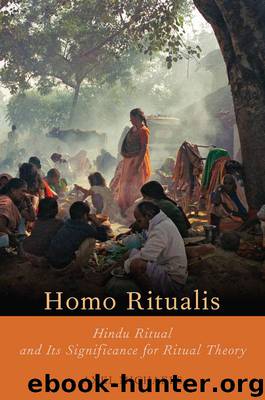Homo Ritualis: Hindu Ritual and Its Significance for Ritual Theory (Oxford Ritual Studies) by Michaels Axel

Author:Michaels, Axel [Michaels, Axel]
Language: eng
Format: epub
Publisher: Oxford University Press
Published: 2015-11-02T17:00:00+00:00
5.2 The Girl’s Initiation
The question of how to conceptualize and denote an event such as “initiation” is crucial. If, for instance, the aspect of education and learning of the Veda as well as the importance of the son for the patrilineage are highlighted, it appears that Hindu girls are not initiated. If, however, the aspect of identification with immortality or the integration of a child in the lineage is stressed, the situation looks different. To illustrate this, we again have to enter the Kathmandu Valley, where so many rare rituals have been preserved. Among these is the mysterious Ihi ritual, the marriage of a Newar maiden to a god.5 The brides in such cases are very young, between three and ten years of age. In the decisive instant of the ritual, the girl holds a fruit of the wood apple or bel tree in her hands, resting her hands at the same time in the hands of her father, while the mother affixes a small leaf of gold to the child’s forehead and places a small leaf of silver on the fruit. For foreign observers, the matter of which god her father is marrying the child to remains a secret. Is she now married to the god Śiva, to whom the bel fruit is dedicated? Or is it the god Viṣṇu, as one occasionally may read, or Buddha, as assumed by the Buddhist Newars?
The parents of the “bride” among the Newars, as well as their daughters, often also do not exactly know which god their children are being entrusted to. In comparison to monotheistic religions, this shows a fundamentally different attitude toward the gods. For in Hinduism, the god is not to be reduced to an aspect or only one identity. It would be downright presumptuous to want to know precisely who or what the god is. In Hinduism, gods are especially powerful when they have several different identities, names, and appearances. It would be, on the other hand, “weak” to reduce the manifold to the level of the one.
Although the divine “spouse” remains inscrutable, for many Newars, this ritual, which is celebrated in public places over a period of two days, is regarded as a “real” wedding. It is said that the girls thus avoid the dire fate of the widow in Hinduism, for the god will never die, and the girl will never become a widow—even though the later human spouse will not be immortal.
In fact, some of the scenes of this ritual do correspond to a proper wedding. The father gives the girl as a “virgin gift” (kanyādāna) to her “spouse”; she receives a marriage sari, walks around the sacred fire, and takes seven ritual steps (saptapadī) into her new life. But an exact analysis shows that in the Ihi ritual, the arrival of the woman-to-be in society and her domicile, the town, is being celebrated. It is thus more an initiation, the acceptance of the maiden in the world of the adults and ancestors, rather than a wedding, that will avoid future widowhood.
Download
This site does not store any files on its server. We only index and link to content provided by other sites. Please contact the content providers to delete copyright contents if any and email us, we'll remove relevant links or contents immediately.
Fingersmith by Sarah Waters(2491)
Kundalini by Gopi Krishna(2138)
Wheels of Life by Anodea Judith(2099)
Indian Mythology by Devdutt Pattanaik(1904)
The Bhagavad Gita by Bibek Debroy(1902)
The Yoga of Jesus: Understanding the Hidden Teachings of the Gospels by Paramahansa Yogananda(1807)
Autobiography of a Yogi (Complete Edition) by Yogananda Paramahansa(1778)
The Man from the Egg by Sudha Murty(1751)
The Book of Secrets: 112 Meditations to Discover the Mystery Within by Osho(1634)
Chakra Mantra Magick by Kadmon Baal(1619)
The Sparsholt Affair by Alan Hollinghurst(1549)
Sparks of Divinity by B. K. S. Iyengar(1497)
Avatar of Night by Tal Brooke(1492)
Gandhi by Ramachandra Guha(1488)
Karma-Yoga and Bhakti-Yoga by Swami Vivekananda(1471)
The Bhagavad Gita (Classics of Indian Spirituality) by Eknath Easwaran(1456)
The Spiritual Teaching of Ramana Maharshi by Ramana Maharshi(1407)
Hinduism: A Very Short Introduction (Very Short Introductions) by Knott Kim(1349)
Skanda Purana (Great Epics of India: Puranas Book 13) by Bibek Debroy & Dipavali Debroy(1346)
